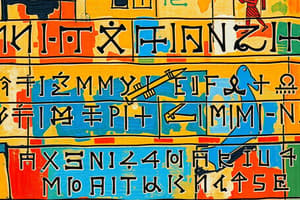Podcast
Questions and Answers
What geographic feature contributed to the agricultural success in Mesopotamia?
What geographic feature contributed to the agricultural success in Mesopotamia?
- Rich alluvial soil from the rivers (correct)
- Deserts surrounding the region
- Icy tundras near the northern borders
- Natural springs in the mountains
How did the economy of Mesopotamia primarily operate?
How did the economy of Mesopotamia primarily operate?
- Reliant on mining and metallurgy only
- Based on trade between cities and countries
- Through a complex tax system
- Primarily on agriculture and livestock (correct)
Which trade routes were significant for Mesopotamian merchants?
Which trade routes were significant for Mesopotamian merchants?
- Routes to the Himalayas and Arctic regions
- Paths leading to the Atlantic Ocean and Americas
- Connections to ancient Greece and Rome
- Links with Egypt, the Persian Gulf, and the Indus Valley (correct)
What notable writing system was developed in Mesopotamia and used for record-keeping?
What notable writing system was developed in Mesopotamia and used for record-keeping?
What was a significant factor that facilitated Mesopotamian trade?
What was a significant factor that facilitated Mesopotamian trade?
What was the primary purpose of cuneiform writing in Mesopotamia?
What was the primary purpose of cuneiform writing in Mesopotamia?
Which of the following achievements is NOT associated with Mesopotamian civilization?
Which of the following achievements is NOT associated with Mesopotamian civilization?
Which of the following achievements is NOT credited to Mesopotamian civilization?
Which of the following achievements is NOT credited to Mesopotamian civilization?
What was a key characteristic of the social structure in Mesopotamia?
What was a key characteristic of the social structure in Mesopotamia?
How did the existence of a lunar calendar benefit Mesopotamians?
How did the existence of a lunar calendar benefit Mesopotamians?
Flashcards are hidden until you start studying
Study Notes
Communication
- Sumerians invented cuneiform writing around 3400 BCE, marking a pivotal advancement in communication.
- Cuneiform was inscribed on clay tablets using a stylus and served multiple purposes such as record-keeping, legal documentation, and literature.
- The ability to document information enabled complex administrative systems and knowledge preservation across generations.
- Scribes, skilled in writing, were crucial for maintaining records and disseminating information throughout society.
Achievements
- Mesopotamia is credited with the development of writing, the establishment of the first cities, and the creation of early legal codes, notably the Code of Hammurabi.
- The region developed a base-60 number system, influencing modern measurements of time and angles.
- Mesopotamians made strides in astronomy, including mapping celestial bodies and creating a lunar calendar.
- Architectural achievements included ziggurats, large stepped temples that reflect engineering skill and religious significance.
Attributes
- The societal structure in Mesopotamia was hierarchical, comprising kings, priests, nobles, merchants, and farmers.
- Religion was integral to everyday life, with city-states dedicated to specific patron deities believed to influence natural forces and human fate.
- Rituals, offerings, and temple worship were key practices to appease the gods and maintain societal harmony.
- Legal codes were established to uphold justice and social order, reflecting the civilization's commitment to law and governance.
Geography
- Mesopotamia is situated in the Fertile Crescent between the Tigris and Euphrates rivers, which significantly influenced its development.
- The rich alluvial soil fostered agriculture, allowing for the growth of crops like barley, wheat, and flax.
- Food surpluses led to population growth and the rise of cities such as Ur, Uruk, and Babylon.
- The region's unpredictable flooding necessitated advanced irrigation and water management systems, enhancing engineering and organizational skills.
Economy
- Agriculture formed the backbone of the Mesopotamian economy, supported by the region's fertile land which produced surplus crops.
- Mixed farming practices included crop cultivation alongside livestock rearing (cattle, sheep, goats).
- Craft industries such as pottery, weaving, and metallurgy contributed to both local consumption and trade.
- Trade initially relied on barter, evolving over time to incorporate currency like the shekel for more efficient economic transactions.
Trade and Commerce
- Mesopotamian civilization thrived on trade to supplement the lack of natural resources, including stone, timber, and metals.
- Surplus agricultural products and crafted goods were exchanged for essential materials like copper, timber, and gemstones.
- Long-distance trade routes were established both overland and via river, facilitating not only the exchange of goods but also the transfer of ideas and cultural practices.
Studying That Suits You
Use AI to generate personalized quizzes and flashcards to suit your learning preferences.




